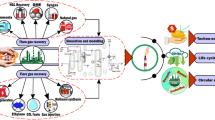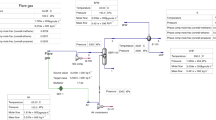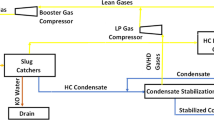Abstract
To combat the increased emission rate and energy waste, a business case for an online optimizer was established to examine the energy-saving and emission reduction figures. Prior to embarking on this study, there is a need to understand the performance of oil and gas companies in managing the continuous flared gas. From the data gathered, it was quite evident that oil and gas operators do not significantly invest in optimizing gas flaring. The survey has included 706 participants from more than 59 different countries and indicated that there is a lack of awareness where regular monitoring of flared gas is overlooked. The survey shows about 17.6% of the participants never analyzed flared gas compositions, while only 36.6% of participants do this on monthly basis. More importantly, the survey indicated that most participants don’t update their process operating conditions in response to day and night or yearly seasons thermal conditions. The optimization study is primarily focusing on having an online flared gas controller technique to continually monitor and analyze flared gas compositions with an intention to automatically manipulate separator operating conditions to increase the flared gas recovery. This approach was tested using a dynamic model developed for three real offshore and onshore oil and gas fields in Egypt and Saudi Arabia. In the three cases of study, this approach was able to adjust the operating conditions of the separator based on the flared gas analysis and the objective function identified to largely recover heavy hydrocarbons and control flared gas.















Similar content being viewed by others
References
Ahmed, T.: Reservoir Engineering Handbook. Gulf Professional Publishing, Houston (2018)
Abdel-Aal, H.K., Aggour, M.A., Fahim, M.A.: Petroleum and Gas Field Processing. CRC Press, Boca Raton (2015)
McCain, W.D., Jr.: Properties of Petroleum Fluids. PennWell Corporation, Tulsa (2017)
Ahmed, T., McKinney, P.: Advanced Reservoir Engineering. Gulf professional publishing, Houston (2004)
Kaldany, R.: Global gas flaring reduction: a time for action! In: A Keynote Speech Presented at Global Forum on Flaring and Gas Utilization, Paris, p. 2006 (2006)
Natural gas flaring in Permian hits record high in Q1. Pipeline Gas J 246(7) (2019)
Kim, K.-H., Shon, Z.-H., Kim, M.-Y., Sunwoo, Y., Jeon, E.-C., Hong, J.H.: Major aromatic VOC in the ambient air in the proximity of an urban landfill facility. J. Hazard. Mater. 150(3), 754–764 (2008). https://doi.org/10.1016/j.jhazmat.2007.05.038
Gillingham, K., Stock, J.H.: The cost of reducing greenhouse gas emissions. J. Econ. Perspect. 32(4), 53–72 (2018)
(IMF), I.M.F.: Fiscal Monitor: How to Mitigate Climate Change (2019)
Five percent of world’s natural gas wasted, GE report says. press release, general electric official website (2011)
French, D.: 1997 Kyoto Protocol to the 1992 UN framework convention on climate change. J Environ mental Law 10(2), 227–239 (1998)
IEA.: Optimising Russian natural gas: reform and climate policy. OECD Publishing, Paris (2006)
Glazer, Y.R., Kjellsson, J.B., Sanders, K.T., Webber, M.E.: Potential for using energy from flared gas for on-site hydraulic fracturing wastewater treatment in Texas. Environ. Sci. Technol. Lett. 1(7), 300–304 (2014)
Mazumder, M., Chen, L., Xu, Q.: Integrated ejector-based flare gas recovery and on-site desalination of produced water in shale gas production. Chem. Eng. Technol. 43(2), 200–210 (2020)
Kar, A., Bahadur, V.: Comparing three methods for waste natural gas-based water production: reverse osmosis, thermal desalination and atmospheric water harvesting. In: ASTFE Digital Library. Begel House Inc (2019)
Amak Plan.: Blue Skies, Clean Air. https://en.shana.ir/news/118705/ (2007). Accessed 28 Sept 2020
Matranga, K.R., Myers, A.L., Glandt, E.D.: Storage of natural gas by adsorption on activated carbon. Chem. Eng. Sci. 47(7), 1569–1579 (1992). https://doi.org/10.1016/0009-2509(92)85005-V
Khan, M.I., Yasmin, T., Shakoor, A.: Technical overview of compressed natural gas (CNG) as a transportation fuel. Renew. Sustain. Energy Rev. 51, 785–797 (2015). https://doi.org/10.1016/j.rser.2015.06.053
Layfield, M.: Creating value from flared natural gas. In: Abu Dhabi International Petroleum Exhibition and Conference 2015. Society of Petroleum Engineers
Thomas, S., Dawe, R.A.: Review of ways to transport natural gas energy from countries which do not need the gas for domestic use. Energy 28(14), 1461–1477 (2003). https://doi.org/10.1016/S0360-5442(03)00124-5
Shanmugam, G.J.: Production: Handbook of Petroleum Exploration and Production (2012)
Gudmundsson, J., Andersson, V., Levik, O., Parlaktuna, M.: Hydrate concept for capturing associated gas. In: European Petroleum Conference. Society of Petroleum Engineers (1998)
Gudmundsson, J., Andersson, V., Durgut, I., Levik, O., Mork, M.: NGH on FPSO-Slurry process and cost estimate. In: SPE Annual Technical Conference and Exhibition. Society of Petroleum Engineers (1999)
Taylor, M., Dawe, R.A., Thomas, S.: Fire and ice: gas hydrate transportation—a possibility for the Caribbean region. In: SPE Latin American and Caribbean Petroleum Engineering Conference. Society of Petroleum Engineers (2003)
Hall, K.R.: A new gas to liquids (GTL) or gas to ethylene (GTE) technology. Catal. Today 106(1), 243–246 (2005). https://doi.org/10.1016/j.cattod.2005.07.176
Ghorbani, I.: Necessity of recovery of associated gas and novel applicable technologies. In: 21st World Petroleum Congress. World Petroleum Congress (2014)
Lo Brutto, F., Layfield, M.: Exploring technologies and concepts for creating value from flared and vented gas. In: Offshore Mediterranean Conference and Exhibition. Offshore Mediterranean Conference (2017)
Brown, J., Law, C.Y., Fielden, K., Dee, C.-S., Pollock, N.J.: Small-scale technology solutions to eliminate flaring. APPEA J. 56(2), 612–612 (2016)
Mousavi, S.M., Lari, K., Salehi, G., Torabi Azad, M.: Technical, economic, and environmental assessment of flare gas recovery system: a case study. In: Energy Sources, Part A: Recovery, Utilization, and Environmental Effects, pp. 1–13 (2020)
Leagas, T., Seefeldt, G., Hoon, D.: Ejector Technology for efficient and cost effective flare gas recovery. In: Proc. GPA-GCC 24 th Annual Technical Conference, Kuwait City, pp. 10–11 (2016)
Van Tilburg, X., Wuertenberger, L.: Emissions from flaring Jubilee field gas. Energy research Centre of the Netherlands ECN, Petten (2010)
Siu, J., Perseval, A.: Effective flare and vent management. In: SPE Trinidad and Tobago Section Energy Resources Conference. Society of Petroleum Engineers (2016)
Tarmoom, I.O.: Gas conservation and flaring minimisation. In: Middle East Oil Show and Conference. Society of Petroleum Engineers (1999)
Al-Kandari, A.H., Kumar, A., Sadeq, O.: Gas flare reduction through operational enhancement and innovative modification and projects. In: IPTC 2012: International Petroleum Technology Conference, pp. cp-280–00110. European Association of Geoscientists & Engineers (2012)
Al-bidaiwi, M.S., Beg, M.S., Al-Muhannadi, M.I.: Gas flaring reduction initiatives in Dukhan oil & gas fields. In: SPE International Production and Operations Conference & Exhibition. Society of Petroleum Engineers (2012)
Labeyrie, H., Rocher, A.: Reducing flaring and improving energy efficiency: an operator. In: SPE International Conference on Health, Safety and Environment in Oil and Gas Exploration and Production. Society of Petroleum Engineers (2010)
Allamaraju, J.P., Mukherjee, R.: Successful implementation of flare gas recovery systems in Gasco plants. In: Abu Dhabi International Petroleum Exhibition & Conference. Society of Petroleum Engineers (2016)
Saadawi, H.: Ten years' experience with flare gas recovery systems in Abu Dhabi. In: SPE Annual Technical Conference and Exhibition. Society of Petroleum Engineers (2013)
Salu, S.A., Soliman, M., Ansari, N.A.K.: Unconventional flare gas recovery systems (FGRS). In: SPE Saudi Arabia Section Technical Symposium and Exhibition. Society of Petroleum Engineers (2014)
Agrawal, H., Al Shuayli, M., Salmani, M.: Reducing operational flaring through ALARP Based decision making. In: Abu Dhabi International Petroleum Exhibition & Conference. Society of Petroleum Engineers (2017)
Online survey tool (1999). https://www.surveymonkey.com
Schaschke, C.: A dictionary of chemical engineering. OUP, Oxford (2014)
Witlox, H.W.M., Fernandez, M., Harper, M., Oke, A., Stene, J., Xu, Y.: Verification and validation of Phast consequence models for accidental releases of toxic or flammable chemicals to the atmosphere. J. Loss Prev. Process Ind. 55, 457–470 (2018). https://doi.org/10.1016/j.jlp.2018.07.014
Phast.: Technical Reference manual Model Theory—Review-Validation (2016)
OPGEE Model.: https://eao.stanford.edu/research-areas/opgee (2017). Accessed 28 Sept 2020
Author information
Authors and Affiliations
Corresponding author
Ethics declarations
Conflict of interest
The authors declare that they have no known competing financial interests or personal relationships that could have appeared to influence the work reported in this paper.
Additional information
Publisher's Note
Springer Nature remains neutral with regard to jurisdictional claims in published maps and institutional affiliations.
Rights and permissions
About this article
Cite this article
Elhagar, M., El-Emam, N., Awad, M. et al. Increase flared gas recovery and emission reduction by separator optimization. Int J Energy Environ Eng 12, 115–130 (2021). https://doi.org/10.1007/s40095-020-00363-z
Received:
Accepted:
Published:
Issue Date:
DOI: https://doi.org/10.1007/s40095-020-00363-z




